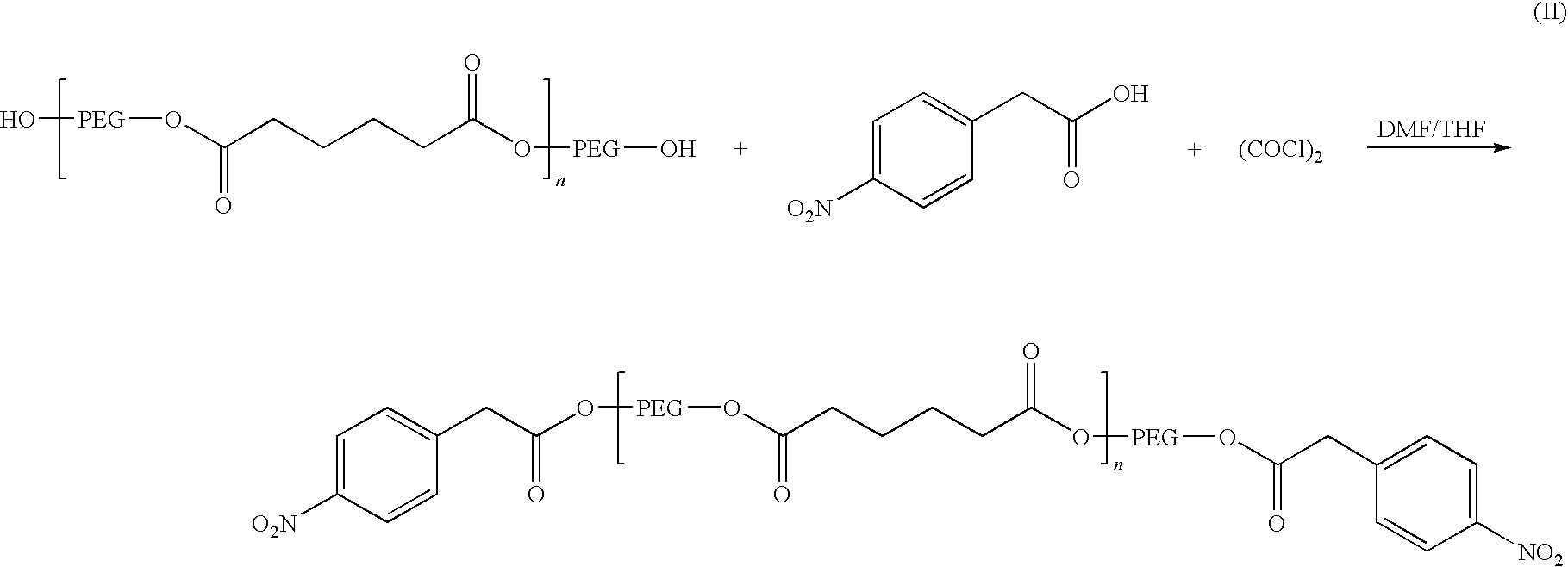Adhesive formulations
a technology of adhesive formulation and cyanoacrylate, applied in the field of adhesives and sealants, can solve the problems of cyanoacrylate adhesive degradation to generate undesirable, limit their usefulness, viral transmission concerns
- Summary
- Abstract
- Description
- Claims
- Application Information
AI Technical Summary
Benefits of technology
Problems solved by technology
Method used
Image
Examples
example 1
[0074]A solution of p-nitrophenylacetic acid (about 12.02 grams) in THF (about 130 ml) at room temperature was treated with oxalyl chloride (about 12.25 grams) and two drops of N,N-dimethylformamide. The resulting mixture was stirred at room temperature for about 1.5 hours and then evaporated to dryness using a rotary evaporator. The resulting acid chloride was mixed with about 50 grams of polyethylene glycol adipate (Mw about 1658). The mixture was heated at about 70° C. for about 16 hours. After cooling to room temperature, it was diluted with THF (about 100 ml), treated with activated carbon (about 2 grams) and CELITE® (about 10 grams). After stirring for about 15 minutes, the mixture was filtered over a pad of CELITE® and washed with THF (about 50 ml). The filtrate was evaporated under reduced pressure. The residue was further dried under vacuum and gave the bis p-nitrophenylacetic acid ester.
[0075]The chemical structure was confirmed by 1H-NMR and 13C NMR. A summary of this rea...
example 2
[0077]A solution of the p-nitrophenylacetate (about 60 grams) produced in Example 1 above in THF (about 300 ml) was successively treated with about 10% palladium on carbon (about 1.61 grams) and ammonium formate (about 19.1 grams). The resulting mixture was heated at about 60° C. for about 2 hours. After cooling to room temperature, the reaction mixture was filtered over CELITE® and the filtrate was evaporated. The residue was partitioned between brine (about 100 ml) and ethyl acetate (about 350 ml). The organic phase was dried over magnesium sulfate, filtered and evaporated to give the corresponding p-aminophenyl acetic ester. Its chemical structure was confirmed by 1H-NMR and 13C NMR. A summary of this reaction is provided below as formula III.
[0078]
example 3
[0079]A solution of the p-aminophenylacetyl ester produced in Example 2 (about 57.3 grams) in THF (about 100 ml) was slowly added using an addition funnel to a solution of triphosgene (about 6.63 grams) in THF (about 200 ml) at room temperature. The reaction mixture was heated at about 65° C. overnight. The reaction mixture was evaporated and the residue was analyzed by NMR and IR and identified as the isocyanate prepolymer of the invention. A summary of this reaction is provided below as formula IV.
[0080]
PUM
| Property | Measurement | Unit |
|---|---|---|
| temperatures | aaaaa | aaaaa |
| temperatures | aaaaa | aaaaa |
| temperatures | aaaaa | aaaaa |
Abstract
Description
Claims
Application Information
 Login to View More
Login to View More - R&D
- Intellectual Property
- Life Sciences
- Materials
- Tech Scout
- Unparalleled Data Quality
- Higher Quality Content
- 60% Fewer Hallucinations
Browse by: Latest US Patents, China's latest patents, Technical Efficacy Thesaurus, Application Domain, Technology Topic, Popular Technical Reports.
© 2025 PatSnap. All rights reserved.Legal|Privacy policy|Modern Slavery Act Transparency Statement|Sitemap|About US| Contact US: help@patsnap.com



